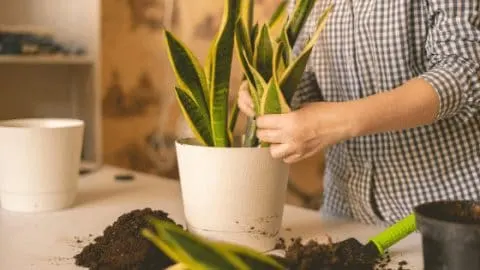Dracaena Trifasciata (dra-SEE-nah try-fas-ee-AY-tuh) goes by many other names, including Good Luck Plant, Golden Birds Nest, Snake Plant, Mother in Law’s Tongue, Sansevieria Trifasciata, and Bowstring Hemp according to the University of Florida.
This is a popular variety of Snake plant because of its hardy nature.
How do you care for Dracaena Trifasciata?
Dracaena trifasciata Takeaways
| Species | Dracaena trifasciata |
| Synonyms | Snake Plant, Sansevieria trifasciata, Mother-in-law's Tongue, Bowstring-Hemp, African Bowstring-Hemp, Spear Plant |
| Family | Asparagaceae |
| Genus | Dracaena |
| Growth | A succulent with thick rhizome supporting rosettes with thick leaves growing vertically from the plant’s base. |
| Height | 3.0 feet |
| Width | 2.4 feet |
| Soil | Well-draining succulent or cactus soil |
| Watering | Every 3-4 weeks |
| Light | Bright indirect |
| Temperature | 50 - Sandy loose soil that has good drainage properties.°F |
| Humidity | 40-50% |
| Fertilizer | Fertilize once a month |
| Propagation | Root division, pups, leaf cuttings feet |
| Toxicity | Toxic to humans and animals such as cats and dogs. Contains saponins. |
Dracaena Trifasciata Care
To care for Dracaena Trifasciata, plant it in a pot with a well-draining sandy or cactus mixture. Provide bright filtered sunlight. Water once a month from below when the top 2 inches of soil is dry (5 cm). The temperature should be between 70-90°F (21-32°C). 40% humidity is optimal. Use a balanced liquid fertilizer of NPK 10-10-10 at half-strength once a month in the growing season.
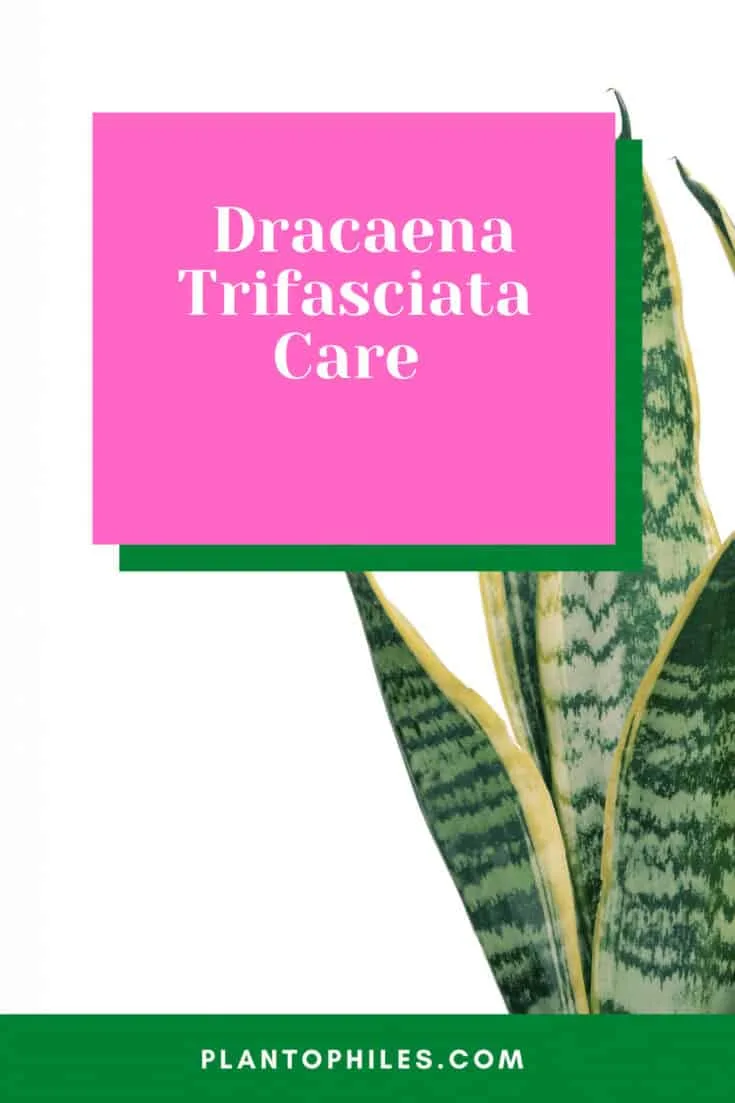
Dracaena trifasciata Care
Table of Contents
Dracaena Trifasciata Care Guide
Dracaena Trifasciata Care Video
Soil
When selecting an appropriate mix for your plant, always choose a well-drained soil mix.
I would suggest planting it in a sandier, loose soil that has good drainage properties.
This plant has arid African roots; therefore, keep it away from overwatering.
Cactus soil is preferred by most growers for Snake Plants. Prepare or buy a potting mixture that has low peat and use a container with drainage holes.
The USDA hardiness zones for this variety are 10b to 12a.
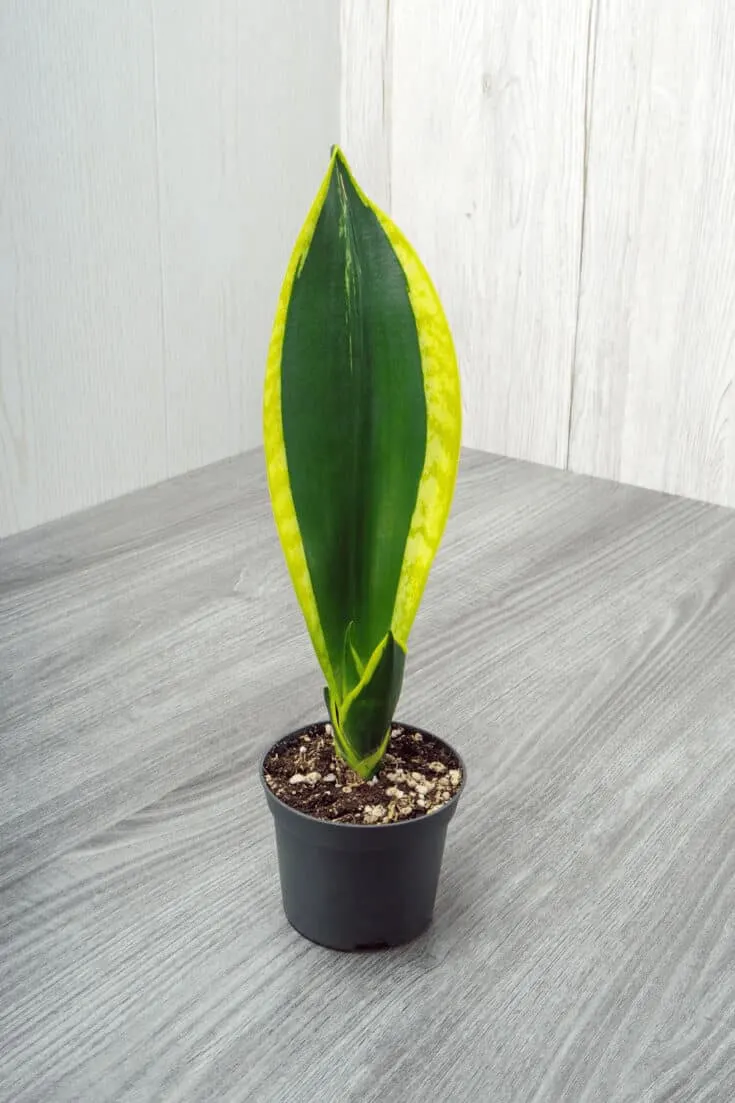
Dracaena trifasciata needs a well-draining potting mix
Water
This forgiving plant is perfect for amateur gardeners.
Watering is the most basic but tricky characteristic of the plant care for Dracaena Trifasciata.
No single watering schedule is suitable for all gardeners because the amount of water required depends on light, temperature, soil, and humidity.
I always recommend using the soil of their plant for proper guidance.
Keep in mind that Dracaena Trifasciata is a succulent plant with drought tolerance.
This plant will not give you a tough time if you forget to water it once in a while.
Generally, in summer and spring, you should allow a few inches of soil to dry before watering.
Whereas in winter, you should water the Dracaena Trifasciata only after a month or two.
Overwatering can quickly lead to root rot.
Underwatering is rarely an issue for this plant. Most of the time, overwatering causes stress. A simple rule is to water your plant whenever the soil is dry.
For this, you should not depend on the dryness of the soil surface; instead, use your fingers and examine a few inches of the soil.
You should water this plant from below as this will encourage the roots to grow downwards.
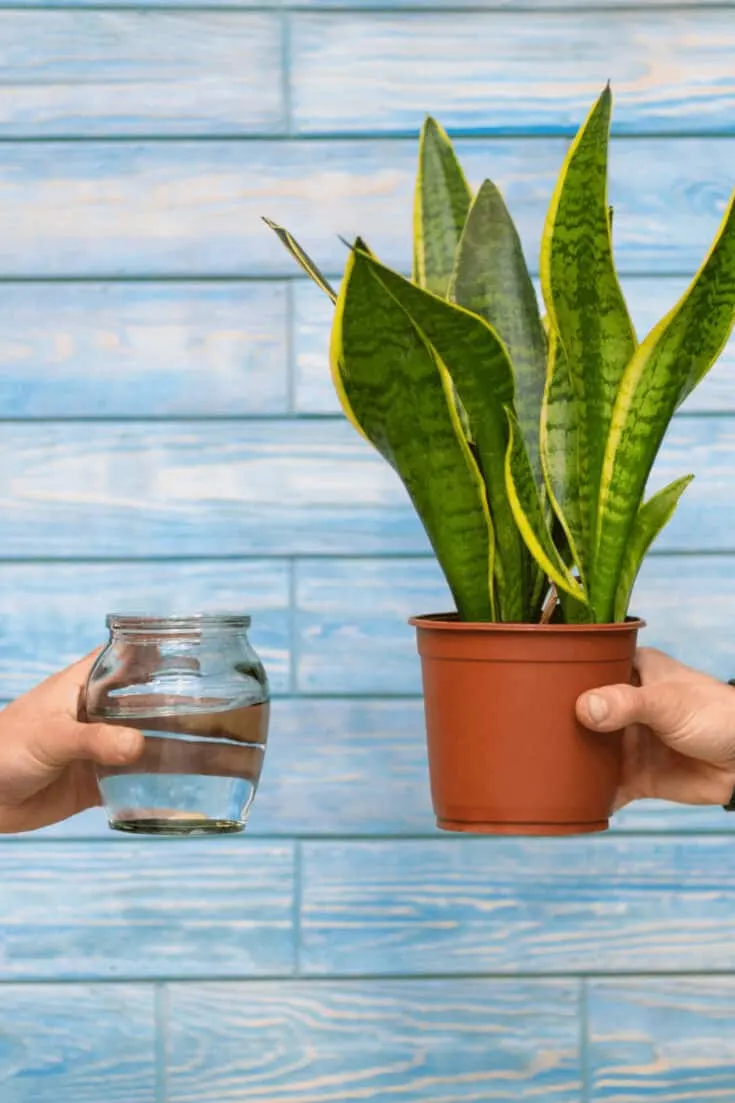
Dracaena trifasciata only needs to be watered once a month
Light
Bright, filtered sunlight that is available throughout the day is the best for Dracaena Trifasciata. However, this plant can also withstand low light or dim situations for long periods compared to other regular houseplants.
Another perfect light condition is partial shade, where your plant gets direct sunlight for a period of 2 or 3 hours during the day.
Temperature
Dracaena Trifasciata will enjoy growing in temperatures that are higher than 50 degrees Fahrenheit (10 degrees Celsius).
For best results, maintain a steady indoor temperature between 70 to 90 degrees Fahrenheit (21 to 32 degrees Celsius).
This plant can tolerate slightly low temperatures. Therefore, your Dracaena Trifasciata will not have trouble during winter.
But still, keep it away from drafty windows to avoid cold damage.
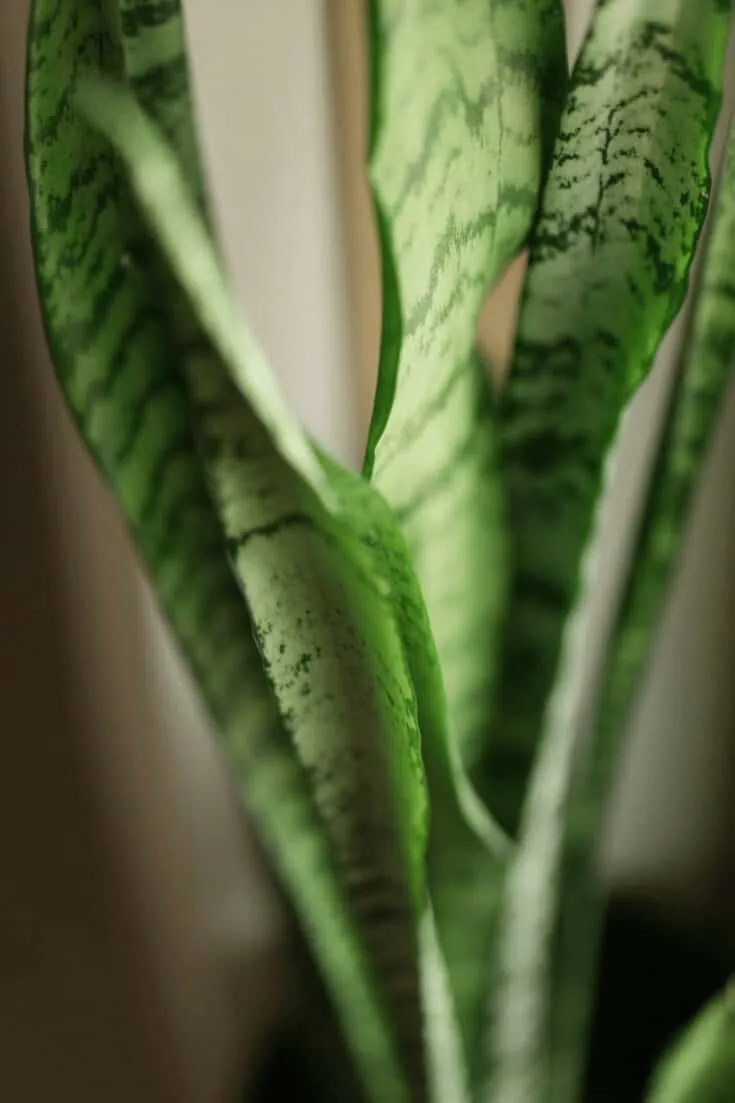
Original non variegated Dracaena trifasciata
Humidity
Average household humidity around 40 % is great for cultivating a Dracaena Trifasciata indoors. This plant tolerates not only low temperature but also low humidity, making it a great addition for gardeners in cold regions.
Fertilizer
This plant has average fertilization needs.
The roots are accustomed to rocky soils; therefore, over-fertilization should be avoided.
You can use a balanced liquid fertilizer.
I use a 10-10-10 fertilizer for this variety because it ensures all the secondary and micronutrients needed for this plant.
You can also opt for a cactus fertilizer if you are using cactus soil.
Always dilute your fertilizer to half-strength to avoid fertilizer burns and over-fertilization.
You can feed it once every month in the growing season.
Repotting
This plant grows very patiently; therefore, it will not require repotting very often.
This plant has strong roots; you should choose a pot made of sturdy material. Otherwise, your pot might break.
You should repot this plant when the roots start emerging from drainage holes or on the soil surface. Another reason to repot is when the leaves have outgrown the container.
Add a small quantity of plant food after repotting to help your plant combat transplant shock.
Repotting should be performed in late winter or early summer; this way, your plant will have several months to establish itself in the new location.
Generally, you can repot this plant after a year. If you want to skip annual repotting, at least refresh the potting soil every year in spring.
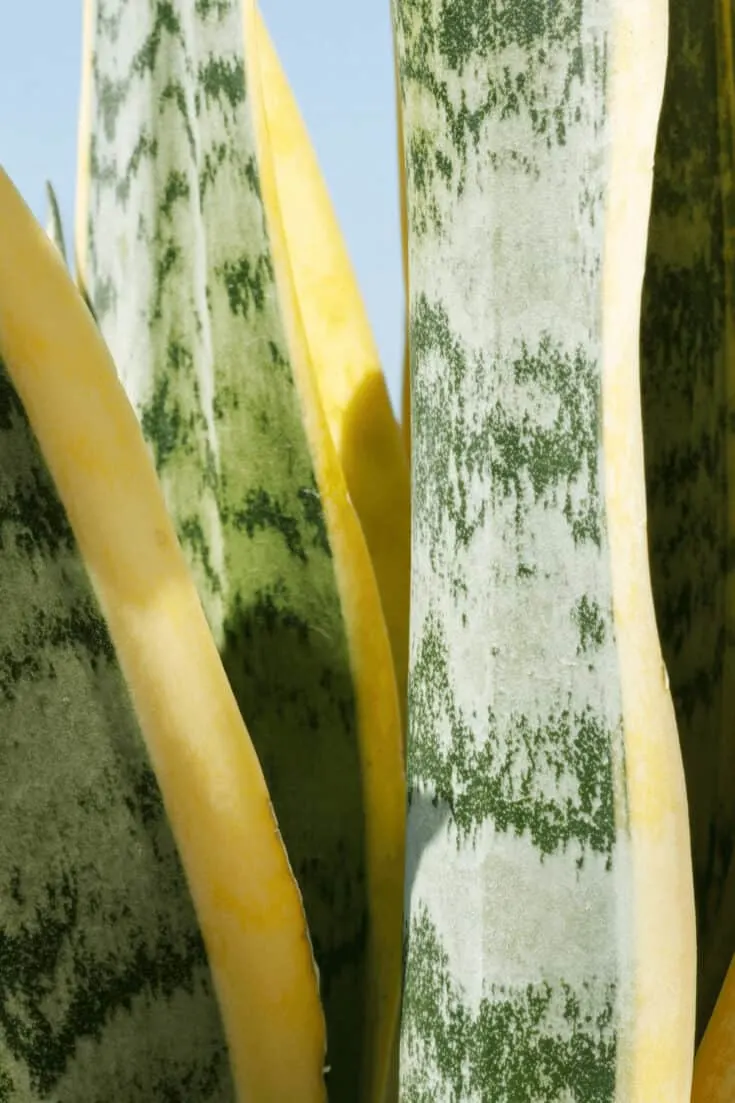
The variegated form of Dracaena trifasciata is more common than the natural form
Pruning
This is an ornamental plant loved for the long, variegated leaves. This is a broadleaf evergreen; therefore, the leaves remain green throughout the year. ¨
But your plant needs some maintenance every few months to maintain the overall size and appearance. You should prune the yellow or faded leaves for healthy growing conditions.
Propagation
Propagating the Dracaena plant is extremely easy. You can propagate this species while repotting or do it any time later in spring or summer.
Root division is the most appropriate propagation method for Dracaena Trifasciata. But I’m discussing 3 methods to help you choose your favorite method.
Stem Cuttings
- Locate a bumpy area on your plant with a healthy leaf. These bumps will produce new roots once propagated. Cut the leaf just below the node using a sterilized scissor.
- Now you have to choose whether you want to propagate it in water or soil. Water propagation is an interesting method because it allows you to see the root development.
- Take a glass vase and fill it with fresh water. Now simply put the cutting in water but make sure only the node is below water.
- Add a teaspoon of rooting hormone for faster growth, but this is optional. Keep the vase in a bright location and change the water every week. Be patient and wait for the roots to grow.
- Roots develop faster in warm months but take longer in winter; therefore, I always recommend propagation in spring. Once the roots are 1-inch long, transfer the young plant to soil.
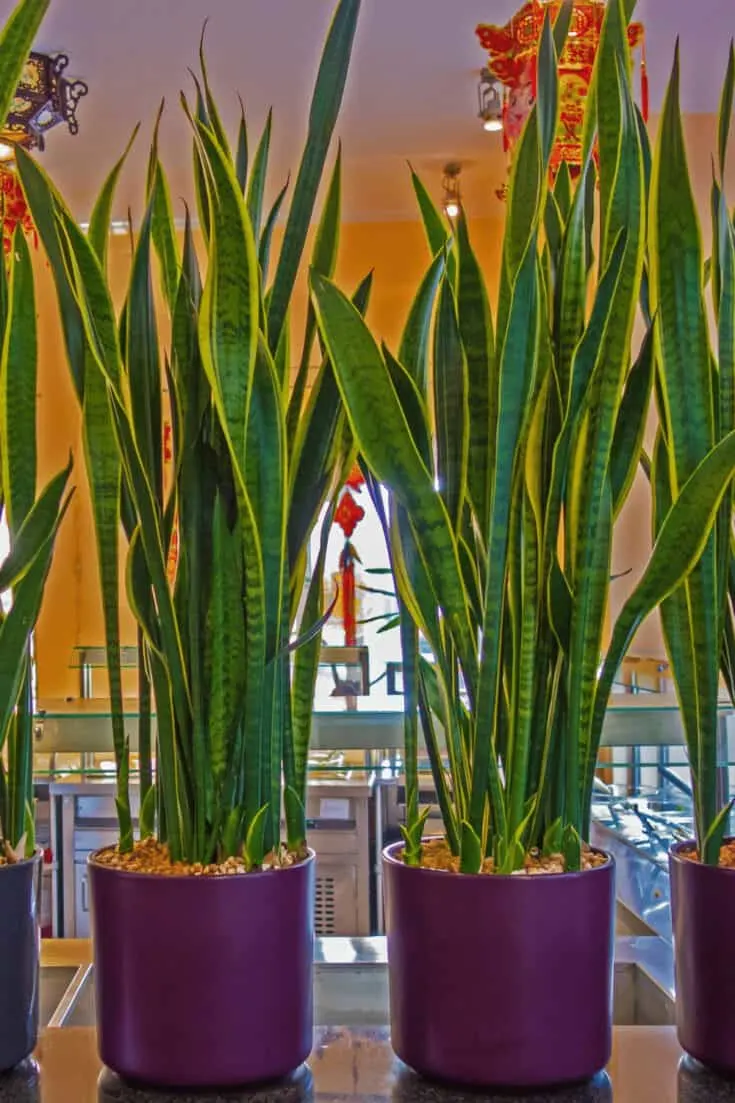
Dracaena trifasciata is often found in restaurants, supermarkets and office spaces because of its easy care
Root Division
- If you are scared about damaging any leaves on the plant while propagating with cuttings, you can perform root division.
- Take the plant out from the container after removing soil around the plant. You can use water to remove soil around the roots.
- Gently separate the roots with a scissor or shears. Do not damage the roots when you do this.
- You should also get rid of any damaged roots or unhealthy foliage. Plant each section in a new container with a potting mixture mentioned in the soil section.
- You can enjoy growing the new plant yourself or share it with a friend.
Air Layering
- In this method, you will allow the node to develop roots before you take cuttings. You will need sphagnum moss, plastic wrap, and pruning shears. Rooting hormone is an optional ingredient.
- Choose a healthy leaf and locate the node on this stem. Create a small wound by making a 1 inch deep cut.
- Apply some rooting hormone at the cut. Now wrap the sphagnum moss around the cut on the stem. You should wet the moss before doing this.
- Secure the moss using the plastic wrap. Leave a small area open for air circulation and watering. This method tricks the wounded part into thinking it’s planted in the soil.
- Once you notice some roots at the wounds, you can separate this cutting from the original plant.
- Plant this cutting in water or soil, and soon you will have many new leaves.
Blooms
The raceme inflorescence bears small flowers. These are usually greenish-white but sometimes cream-colored. The flowers are non-fragrant but have a sticky texture.
In its natural habitat, this plant blooms in winter. Sadly, this variety rarely blooms as an indoor plant. But you can try to replicate the natural environment to help your plant bloom.
According to most growers, the chances of blooming highly depend on the neglect of your plant experiences. So it is best to leave your plant alone if you want it to bloom.
Growth
This plant has a clumping or erect growth habit. It is a great plant with a slow to medium growth rate. This variety has no prominent stems.
The leaves vary in shades of cream, gold, white and green. The fleshy leaves have a leathery texture.
They grow in a rosette pattern to form a cluster, but each leaf has a lanceolate shape. The leaves might look simple but are still showy in a landscape.
The leaves will grow 6 inches (15cm) or more in length and 1-3 inches (2.5-7.6 cm) in width.
It has an adaptable nature for new locations and environments with minimum attention from the gardener; for this reason, I have been rotating this plant in every corner of my house.
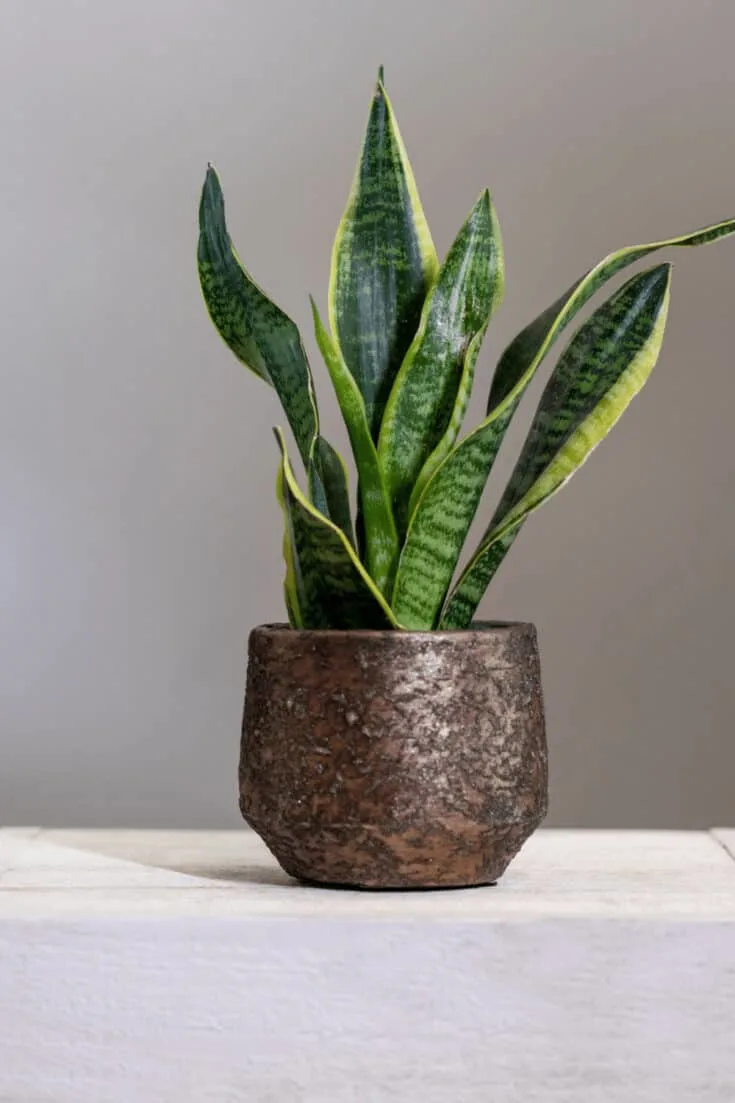
Dracaena trifasciata is growing tubers underground
Dracaena Trifasciata Origin
Coming from Africa, Dracaena Trifasciata is a wonderful houseplant that is often used by interior landscape designers as a ground cover.
The main reason for the vast application of this variety is easy care and durability.
Snake plants were initially cultivated in China because, in Chinese culture, it is believed that these bring virtue.
The botanical name for this specimen is Sansevieria Trifasciata.
According to NC State University, Trifasciata is part of the Asparagaceae family and has a perennial life cycle.
The main attractiveness of this Dracaena is the stiff leaves that grow in clusters.
The sculptured leaves are pointy at the ends, which gives this plant a unique appearance.
The leaves can easily grow 4 to 8 ft. (1.2 to 2.4m) long with the proper environment.
These linear leaves have alternate bands in shades of green, yellow, and white on the outer edges.
Just like Philodendrons, this species is also on the air purification list of NASA. It can help fight sick building syndrome.
This plant tops the list of low-demand houseplants. Learn the plant care for this variety in this article to keep your spiky plant thriving.
Varieties of Dracaena Trifasciata
The Trifasciata family has several variants. Some of them are mentioned below.
Trifasciata Hahnii – a dwarf plant that has short leaves. The leaves have a funnel-shaped rosette structure that resembles a bird’s nest. Each plant has 6 to 12 leaves.
Trifasciata Golden Hahnii – similar to the previous variety, but the leaves are variegated with yellow margins.
Trifasciata Laurentii – with its chimeral genetics, this variety has creamy-yellow, thick margins.
This variety is also known as the variegated Snake plant and must be divided via root divisions rather than leaf propagation.
Trifasciata Twist – this version grows 14 inches tall on average. It is named twist because of the twisted leaves that have yellow variegated margins.
Trifasciata Bantel’s Sensation – this variety has white vertical stripes, and the leaves are narrow. The average mature height for this plant is 3 ft. (0.9m).
Trifasciata Moonshine – this plant has pale silvery-green leaves. Another name for this one is Silver Snake Plant.
Common Problems for Dracaena Trifasciata
Most of the time, this plant is resilient and tough, but it might face the following issues.
Yellowing Leaves
Yellowing of the long leaves indicates overwatering. The first step is to allow your plant’s soil to dry thoroughly.
Now fix your watering schedule by watering your plant more frequently but with less water.
You should also remove all the yellow, dead leaves to help the plant recover from water stress.
Another reason for yellow leaves on this variety is extreme temperatures.
Keep your plant at a consistent temperature that falls within the ideal temperature range.
You can avoid fungus growth or yellowing by following the below precautions:
- Apply the water directly to the potting soil without wetting the leaves.
- Always keep the green leaves free from dust.
- Ensure good air circulation around the plant.
- Get rid of infected foliage as soon as you detect it.
Root Rot
When the stiff, green leaves become mushy, soft, and discolored, your plant might be suffering from root rot. This is a common issue for Snake plants.
Dark, smelly roots indicate unhealthy conditions. Remember, healthy roots are yellow or white-colored.
Discard the unhealthy roots and replant the healthy leaves in a fresh potting mixture.
If the leaves start collapsing, the root rot has damaged the entire root system.
Avoid overwatering the soil in winter because this suffocates the roots and facilitates the growth of fungus. Your container should have plenty of drainages to avoid root rot in the future.
Browning of Tips
There are several reasons for the browning of leaf tips. You can blame cold weather, improper watering, or too much sunlight.
Examine all these conditions for your plant, and make sure you follow the instructions given in the temperature, water, and light sections.
Once you fix these issues, your plant will stop producing brown tips.
All the damaged or discolored leaf tips should be trimmed with clean tools.
You should use a sharp instrument and trim carefully to maintain a natural leaf shape.
Sometimes the leaves stop growing if the tips are trimmed or cut.
Tips for Growing Dracaena Trifasciata
- The soil mix should have good drainage.
- The potting mixture should be allowed to reach dryness in between watering. Else overwatering can kill your plant.
- Avoid extreme light conditions; your plant should receive filtered, bright sunlight for the most part of the day.
- For outdoor planting, a sunny, warm area with protection from direct sunlight is an ideal spot.
- In winter, you should water your Dracaena Trifasciata only to keep the leaves fresh and firm.
- Avoid wetting the leaves while watering your plant, as water sitting on the leaves will cause damage.
- This plant likes staying pot bound, so avoid repotting very often.
Frequently Asked Questions about Dracaena Trifasciata Care
Can Dracaena Trifasciata withstand cold weather?
This plant is a hardy species; it can certainly withstand cold weather better than some other houseplants. For this reason, this variety is a well-known houseplant in colder regions.
What is the maximum height this variety can achieve?
Under optimum conditions, this plant can get 12 feet high.
What happens if my dog eats the leaves of Dracaena Trifasciata?
Dracaena Trifasciata is a low poison species. Your dog will suffer from vomiting, diarrhea, and nausea; therefore, I would recommend keeping it away from your pets.
What conditions are disliked by Dracaena Trifasciata?
This plant hates freezing temperature and water-logged soil; therefore, avoid overwatering and maintain the temperature mentioned previously.
Can this plant withstand low sunlight?
Dracaena Trifasciata is very adaptable; it can grow in poor light or prolonged shade. But I would not recommend that if you want your plant to thrive well, provide filtered sunlight.
Conclusion About Dracaena Trifasciata
This filler plant is highly durable and difficult to kill because it can easily tolerate low light.
Although blooms are rare as an indoor plant, you can still admire them for their unique, long leaves.
Get one for yourself to bring good luck and pure air to your home.
You can easily grow it in a group on the floor or as a tabletop plant.
The green leaves have sharp leaf tips with stripes and a sword-like leaf shape.
Beware and do not allow your pets to chew any foliage of this poisonous plant.
With our simple plant care guide, you can enjoy this low-maintenance plant for several years.
The best part about growing Dracaena Trifasciata is that it is versatile in terms of lighting requirements, like bright filtered sunlight but can also thrive in the dark corners of your house.

Daniel has been a plant enthusiast for over 20 years. He owns hundreds of houseplants and prepares for the chili growing seasons yearly with great anticipation. His favorite plants are plant species in the Araceae family, such as Monstera, Philodendron, and Anthurium. He also loves gardening and is growing hot peppers, tomatoes, and many more vegetables.

